Comprehensive Analysis of UK Taxation: Regulations and Calculations
VerifiedAdded on 2020/01/23
|16
|4720
|50
Report
AI Summary
This report offers a comprehensive overview of the UK taxation system. It begins by describing the tax environment, including direct and indirect taxes such as income tax, corporation tax, capital gains tax, and VAT. The report then analyzes the roles and responsibilities of tax practitioners, emphasizing their importance in advising clients and ensuring compliance with Her Majesty's Revenue and Customs (HMRC) regulations. It also explains the tax obligations of taxpayers and the implications of non-compliance, including penalties for late payments and submissions. The report includes calculations of relevant income, expenses, and allowances, as well as the assessment of taxable amounts for employment and self-employment income. Furthermore, it covers the calculation of chargeable profits and tax liabilities for companies, along with methods to deal with income tax deductions. The report concludes with a discussion on calculating capital gains and losses, and the corresponding tax payable. Overall, this report provides a detailed analysis of the UK taxation system, including practical examples and calculations.

TAXATION
1
1
Paraphrase This Document
Need a fresh take? Get an instant paraphrase of this document with our AI Paraphraser
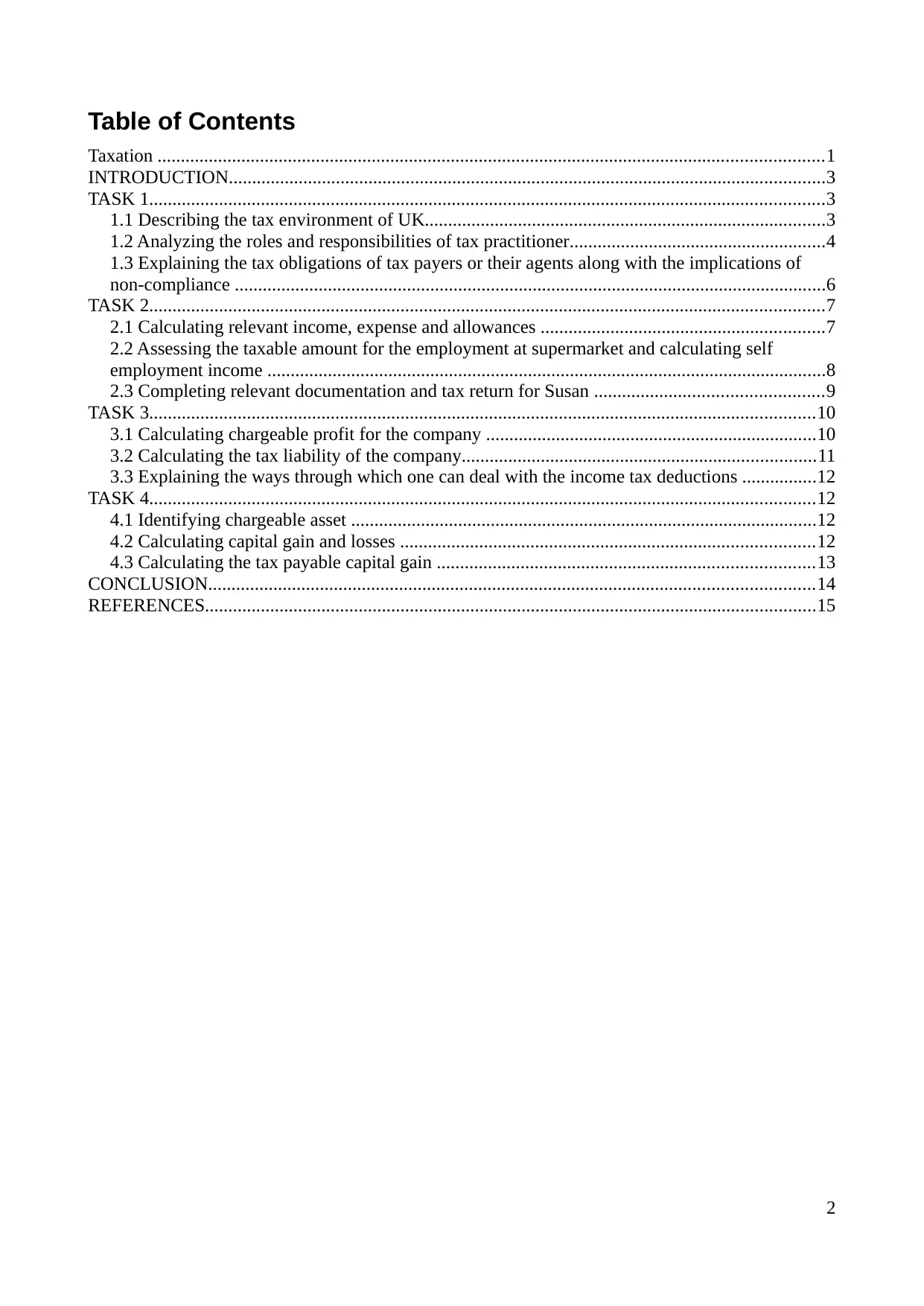
Table of Contents
Taxation ...............................................................................................................................................1
INTRODUCTION................................................................................................................................3
TASK 1.................................................................................................................................................3
1.1 Describing the tax environment of UK......................................................................................3
1.2 Analyzing the roles and responsibilities of tax practitioner.......................................................4
1.3 Explaining the tax obligations of tax payers or their agents along with the implications of
non-compliance ...............................................................................................................................6
TASK 2.................................................................................................................................................7
2.1 Calculating relevant income, expense and allowances .............................................................7
2.2 Assessing the taxable amount for the employment at supermarket and calculating self
employment income ........................................................................................................................8
2.3 Completing relevant documentation and tax return for Susan .................................................9
TASK 3...............................................................................................................................................10
3.1 Calculating chargeable profit for the company .......................................................................10
3.2 Calculating the tax liability of the company............................................................................11
3.3 Explaining the ways through which one can deal with the income tax deductions ................12
TASK 4...............................................................................................................................................12
4.1 Identifying chargeable asset ....................................................................................................12
4.2 Calculating capital gain and losses .........................................................................................12
4.3 Calculating the tax payable capital gain .................................................................................13
CONCLUSION..................................................................................................................................14
REFERENCES...................................................................................................................................15
2
Taxation ...............................................................................................................................................1
INTRODUCTION................................................................................................................................3
TASK 1.................................................................................................................................................3
1.1 Describing the tax environment of UK......................................................................................3
1.2 Analyzing the roles and responsibilities of tax practitioner.......................................................4
1.3 Explaining the tax obligations of tax payers or their agents along with the implications of
non-compliance ...............................................................................................................................6
TASK 2.................................................................................................................................................7
2.1 Calculating relevant income, expense and allowances .............................................................7
2.2 Assessing the taxable amount for the employment at supermarket and calculating self
employment income ........................................................................................................................8
2.3 Completing relevant documentation and tax return for Susan .................................................9
TASK 3...............................................................................................................................................10
3.1 Calculating chargeable profit for the company .......................................................................10
3.2 Calculating the tax liability of the company............................................................................11
3.3 Explaining the ways through which one can deal with the income tax deductions ................12
TASK 4...............................................................................................................................................12
4.1 Identifying chargeable asset ....................................................................................................12
4.2 Calculating capital gain and losses .........................................................................................12
4.3 Calculating the tax payable capital gain .................................................................................13
CONCLUSION..................................................................................................................................14
REFERENCES...................................................................................................................................15
2
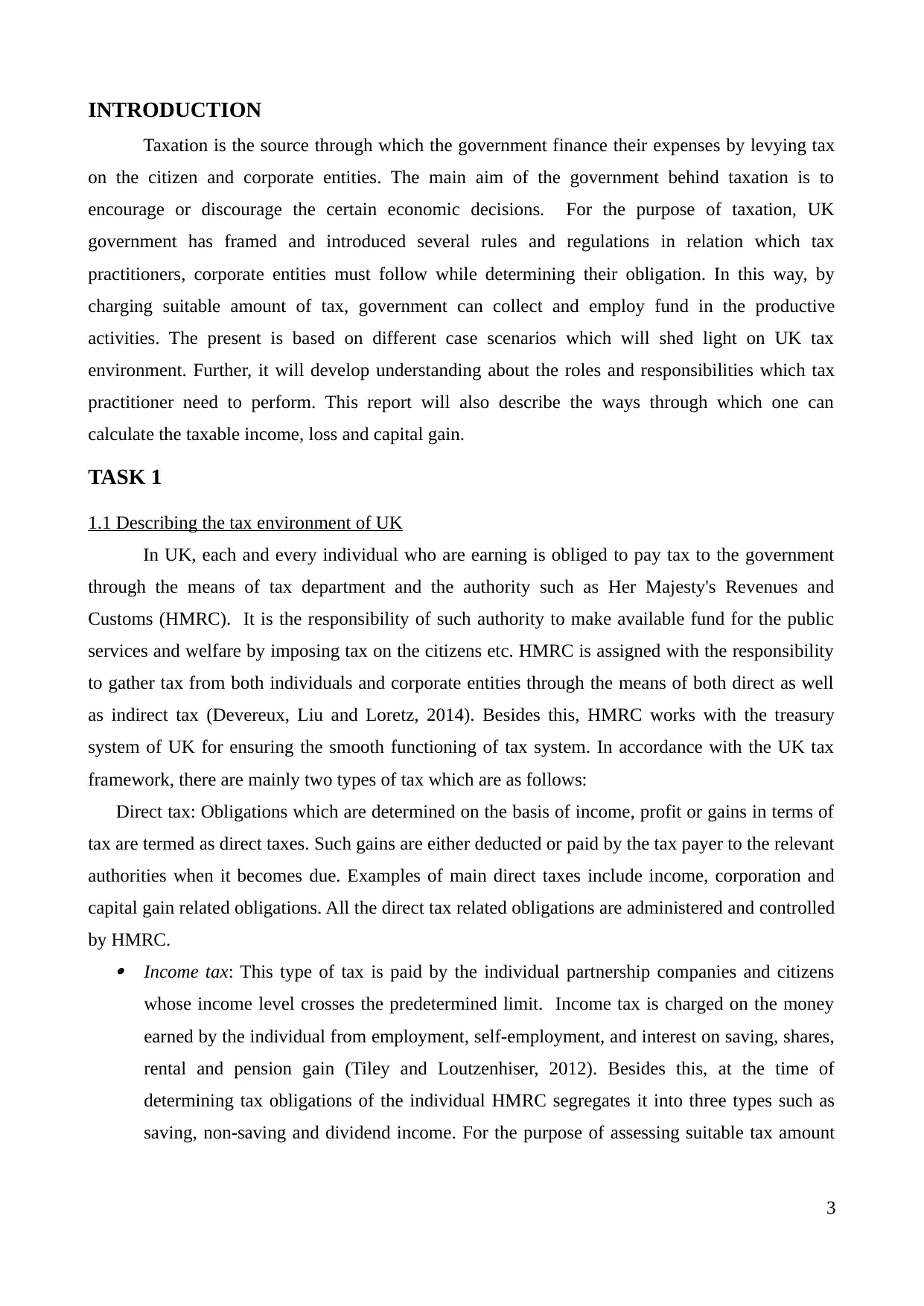
INTRODUCTION
Taxation is the source through which the government finance their expenses by levying tax
on the citizen and corporate entities. The main aim of the government behind taxation is to
encourage or discourage the certain economic decisions. For the purpose of taxation, UK
government has framed and introduced several rules and regulations in relation which tax
practitioners, corporate entities must follow while determining their obligation. In this way, by
charging suitable amount of tax, government can collect and employ fund in the productive
activities. The present is based on different case scenarios which will shed light on UK tax
environment. Further, it will develop understanding about the roles and responsibilities which tax
practitioner need to perform. This report will also describe the ways through which one can
calculate the taxable income, loss and capital gain.
TASK 1
1.1 Describing the tax environment of UK
In UK, each and every individual who are earning is obliged to pay tax to the government
through the means of tax department and the authority such as Her Majesty's Revenues and
Customs (HMRC). It is the responsibility of such authority to make available fund for the public
services and welfare by imposing tax on the citizens etc. HMRC is assigned with the responsibility
to gather tax from both individuals and corporate entities through the means of both direct as well
as indirect tax (Devereux, Liu and Loretz, 2014). Besides this, HMRC works with the treasury
system of UK for ensuring the smooth functioning of tax system. In accordance with the UK tax
framework, there are mainly two types of tax which are as follows:
Direct tax: Obligations which are determined on the basis of income, profit or gains in terms of
tax are termed as direct taxes. Such gains are either deducted or paid by the tax payer to the relevant
authorities when it becomes due. Examples of main direct taxes include income, corporation and
capital gain related obligations. All the direct tax related obligations are administered and controlled
by HMRC. Income tax: This type of tax is paid by the individual partnership companies and citizens
whose income level crosses the predetermined limit. Income tax is charged on the money
earned by the individual from employment, self-employment, and interest on saving, shares,
rental and pension gain (Tiley and Loutzenhiser, 2012). Besides this, at the time of
determining tax obligations of the individual HMRC segregates it into three types such as
saving, non-saving and dividend income. For the purpose of assessing suitable tax amount
3
Taxation is the source through which the government finance their expenses by levying tax
on the citizen and corporate entities. The main aim of the government behind taxation is to
encourage or discourage the certain economic decisions. For the purpose of taxation, UK
government has framed and introduced several rules and regulations in relation which tax
practitioners, corporate entities must follow while determining their obligation. In this way, by
charging suitable amount of tax, government can collect and employ fund in the productive
activities. The present is based on different case scenarios which will shed light on UK tax
environment. Further, it will develop understanding about the roles and responsibilities which tax
practitioner need to perform. This report will also describe the ways through which one can
calculate the taxable income, loss and capital gain.
TASK 1
1.1 Describing the tax environment of UK
In UK, each and every individual who are earning is obliged to pay tax to the government
through the means of tax department and the authority such as Her Majesty's Revenues and
Customs (HMRC). It is the responsibility of such authority to make available fund for the public
services and welfare by imposing tax on the citizens etc. HMRC is assigned with the responsibility
to gather tax from both individuals and corporate entities through the means of both direct as well
as indirect tax (Devereux, Liu and Loretz, 2014). Besides this, HMRC works with the treasury
system of UK for ensuring the smooth functioning of tax system. In accordance with the UK tax
framework, there are mainly two types of tax which are as follows:
Direct tax: Obligations which are determined on the basis of income, profit or gains in terms of
tax are termed as direct taxes. Such gains are either deducted or paid by the tax payer to the relevant
authorities when it becomes due. Examples of main direct taxes include income, corporation and
capital gain related obligations. All the direct tax related obligations are administered and controlled
by HMRC. Income tax: This type of tax is paid by the individual partnership companies and citizens
whose income level crosses the predetermined limit. Income tax is charged on the money
earned by the individual from employment, self-employment, and interest on saving, shares,
rental and pension gain (Tiley and Loutzenhiser, 2012). Besides this, at the time of
determining tax obligations of the individual HMRC segregates it into three types such as
saving, non-saving and dividend income. For the purpose of assessing suitable tax amount
3
⊘ This is a preview!⊘
Do you want full access?
Subscribe today to unlock all pages.

Trusted by 1+ million students worldwide
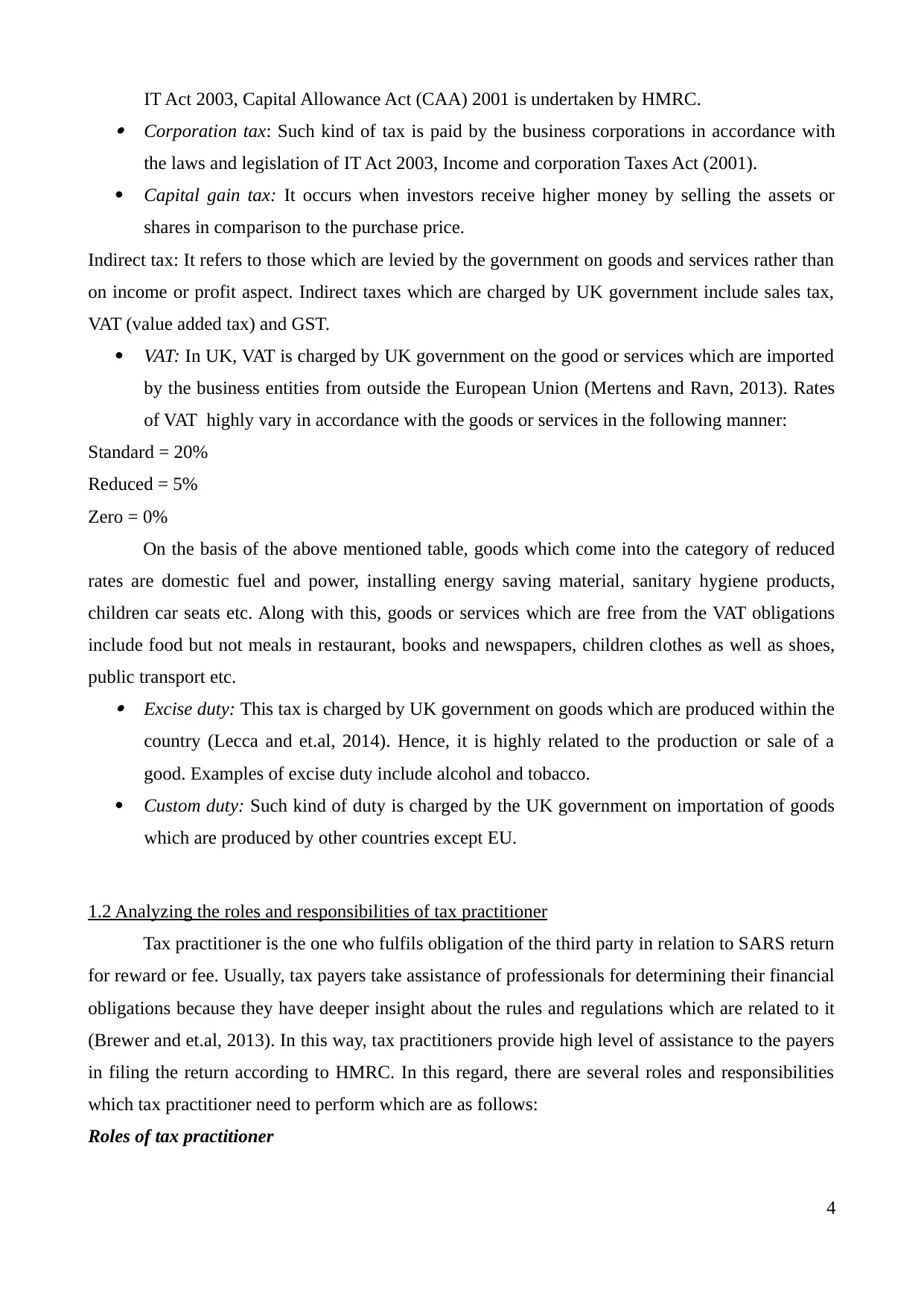
IT Act 2003, Capital Allowance Act (CAA) 2001 is undertaken by HMRC. Corporation tax: Such kind of tax is paid by the business corporations in accordance with
the laws and legislation of IT Act 2003, Income and corporation Taxes Act (2001).
Capital gain tax: It occurs when investors receive higher money by selling the assets or
shares in comparison to the purchase price.
Indirect tax: It refers to those which are levied by the government on goods and services rather than
on income or profit aspect. Indirect taxes which are charged by UK government include sales tax,
VAT (value added tax) and GST.
VAT: In UK, VAT is charged by UK government on the good or services which are imported
by the business entities from outside the European Union (Mertens and Ravn, 2013). Rates
of VAT highly vary in accordance with the goods or services in the following manner:
Standard = 20%
Reduced = 5%
Zero = 0%
On the basis of the above mentioned table, goods which come into the category of reduced
rates are domestic fuel and power, installing energy saving material, sanitary hygiene products,
children car seats etc. Along with this, goods or services which are free from the VAT obligations
include food but not meals in restaurant, books and newspapers, children clothes as well as shoes,
public transport etc. Excise duty: This tax is charged by UK government on goods which are produced within the
country (Lecca and et.al, 2014). Hence, it is highly related to the production or sale of a
good. Examples of excise duty include alcohol and tobacco.
Custom duty: Such kind of duty is charged by the UK government on importation of goods
which are produced by other countries except EU.
1.2 Analyzing the roles and responsibilities of tax practitioner
Tax practitioner is the one who fulfils obligation of the third party in relation to SARS return
for reward or fee. Usually, tax payers take assistance of professionals for determining their financial
obligations because they have deeper insight about the rules and regulations which are related to it
(Brewer and et.al, 2013). In this way, tax practitioners provide high level of assistance to the payers
in filing the return according to HMRC. In this regard, there are several roles and responsibilities
which tax practitioner need to perform which are as follows:
Roles of tax practitioner
4
the laws and legislation of IT Act 2003, Income and corporation Taxes Act (2001).
Capital gain tax: It occurs when investors receive higher money by selling the assets or
shares in comparison to the purchase price.
Indirect tax: It refers to those which are levied by the government on goods and services rather than
on income or profit aspect. Indirect taxes which are charged by UK government include sales tax,
VAT (value added tax) and GST.
VAT: In UK, VAT is charged by UK government on the good or services which are imported
by the business entities from outside the European Union (Mertens and Ravn, 2013). Rates
of VAT highly vary in accordance with the goods or services in the following manner:
Standard = 20%
Reduced = 5%
Zero = 0%
On the basis of the above mentioned table, goods which come into the category of reduced
rates are domestic fuel and power, installing energy saving material, sanitary hygiene products,
children car seats etc. Along with this, goods or services which are free from the VAT obligations
include food but not meals in restaurant, books and newspapers, children clothes as well as shoes,
public transport etc. Excise duty: This tax is charged by UK government on goods which are produced within the
country (Lecca and et.al, 2014). Hence, it is highly related to the production or sale of a
good. Examples of excise duty include alcohol and tobacco.
Custom duty: Such kind of duty is charged by the UK government on importation of goods
which are produced by other countries except EU.
1.2 Analyzing the roles and responsibilities of tax practitioner
Tax practitioner is the one who fulfils obligation of the third party in relation to SARS return
for reward or fee. Usually, tax payers take assistance of professionals for determining their financial
obligations because they have deeper insight about the rules and regulations which are related to it
(Brewer and et.al, 2013). In this way, tax practitioners provide high level of assistance to the payers
in filing the return according to HMRC. In this regard, there are several roles and responsibilities
which tax practitioner need to perform which are as follows:
Roles of tax practitioner
4
Paraphrase This Document
Need a fresh take? Get an instant paraphrase of this document with our AI Paraphraser
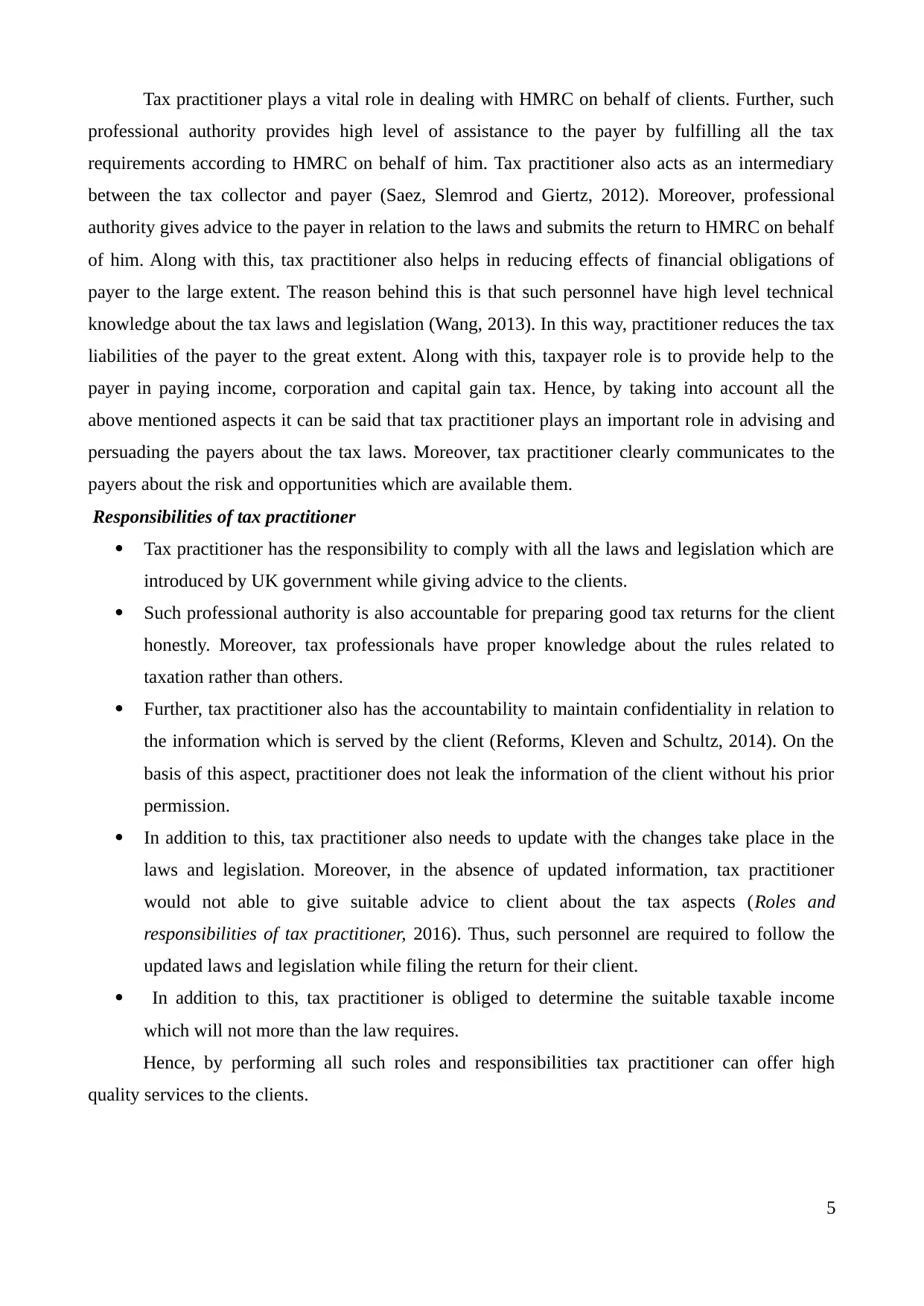
Tax practitioner plays a vital role in dealing with HMRC on behalf of clients. Further, such
professional authority provides high level of assistance to the payer by fulfilling all the tax
requirements according to HMRC on behalf of him. Tax practitioner also acts as an intermediary
between the tax collector and payer (Saez, Slemrod and Giertz, 2012). Moreover, professional
authority gives advice to the payer in relation to the laws and submits the return to HMRC on behalf
of him. Along with this, tax practitioner also helps in reducing effects of financial obligations of
payer to the large extent. The reason behind this is that such personnel have high level technical
knowledge about the tax laws and legislation (Wang, 2013). In this way, practitioner reduces the tax
liabilities of the payer to the great extent. Along with this, taxpayer role is to provide help to the
payer in paying income, corporation and capital gain tax. Hence, by taking into account all the
above mentioned aspects it can be said that tax practitioner plays an important role in advising and
persuading the payers about the tax laws. Moreover, tax practitioner clearly communicates to the
payers about the risk and opportunities which are available them.
Responsibilities of tax practitioner
Tax practitioner has the responsibility to comply with all the laws and legislation which are
introduced by UK government while giving advice to the clients.
Such professional authority is also accountable for preparing good tax returns for the client
honestly. Moreover, tax professionals have proper knowledge about the rules related to
taxation rather than others.
Further, tax practitioner also has the accountability to maintain confidentiality in relation to
the information which is served by the client (Reforms, Kleven and Schultz, 2014). On the
basis of this aspect, practitioner does not leak the information of the client without his prior
permission.
In addition to this, tax practitioner also needs to update with the changes take place in the
laws and legislation. Moreover, in the absence of updated information, tax practitioner
would not able to give suitable advice to client about the tax aspects (Roles and
responsibilities of tax practitioner, 2016). Thus, such personnel are required to follow the
updated laws and legislation while filing the return for their client.
In addition to this, tax practitioner is obliged to determine the suitable taxable income
which will not more than the law requires.
Hence, by performing all such roles and responsibilities tax practitioner can offer high
quality services to the clients.
5
professional authority provides high level of assistance to the payer by fulfilling all the tax
requirements according to HMRC on behalf of him. Tax practitioner also acts as an intermediary
between the tax collector and payer (Saez, Slemrod and Giertz, 2012). Moreover, professional
authority gives advice to the payer in relation to the laws and submits the return to HMRC on behalf
of him. Along with this, tax practitioner also helps in reducing effects of financial obligations of
payer to the large extent. The reason behind this is that such personnel have high level technical
knowledge about the tax laws and legislation (Wang, 2013). In this way, practitioner reduces the tax
liabilities of the payer to the great extent. Along with this, taxpayer role is to provide help to the
payer in paying income, corporation and capital gain tax. Hence, by taking into account all the
above mentioned aspects it can be said that tax practitioner plays an important role in advising and
persuading the payers about the tax laws. Moreover, tax practitioner clearly communicates to the
payers about the risk and opportunities which are available them.
Responsibilities of tax practitioner
Tax practitioner has the responsibility to comply with all the laws and legislation which are
introduced by UK government while giving advice to the clients.
Such professional authority is also accountable for preparing good tax returns for the client
honestly. Moreover, tax professionals have proper knowledge about the rules related to
taxation rather than others.
Further, tax practitioner also has the accountability to maintain confidentiality in relation to
the information which is served by the client (Reforms, Kleven and Schultz, 2014). On the
basis of this aspect, practitioner does not leak the information of the client without his prior
permission.
In addition to this, tax practitioner also needs to update with the changes take place in the
laws and legislation. Moreover, in the absence of updated information, tax practitioner
would not able to give suitable advice to client about the tax aspects (Roles and
responsibilities of tax practitioner, 2016). Thus, such personnel are required to follow the
updated laws and legislation while filing the return for their client.
In addition to this, tax practitioner is obliged to determine the suitable taxable income
which will not more than the law requires.
Hence, by performing all such roles and responsibilities tax practitioner can offer high
quality services to the clients.
5
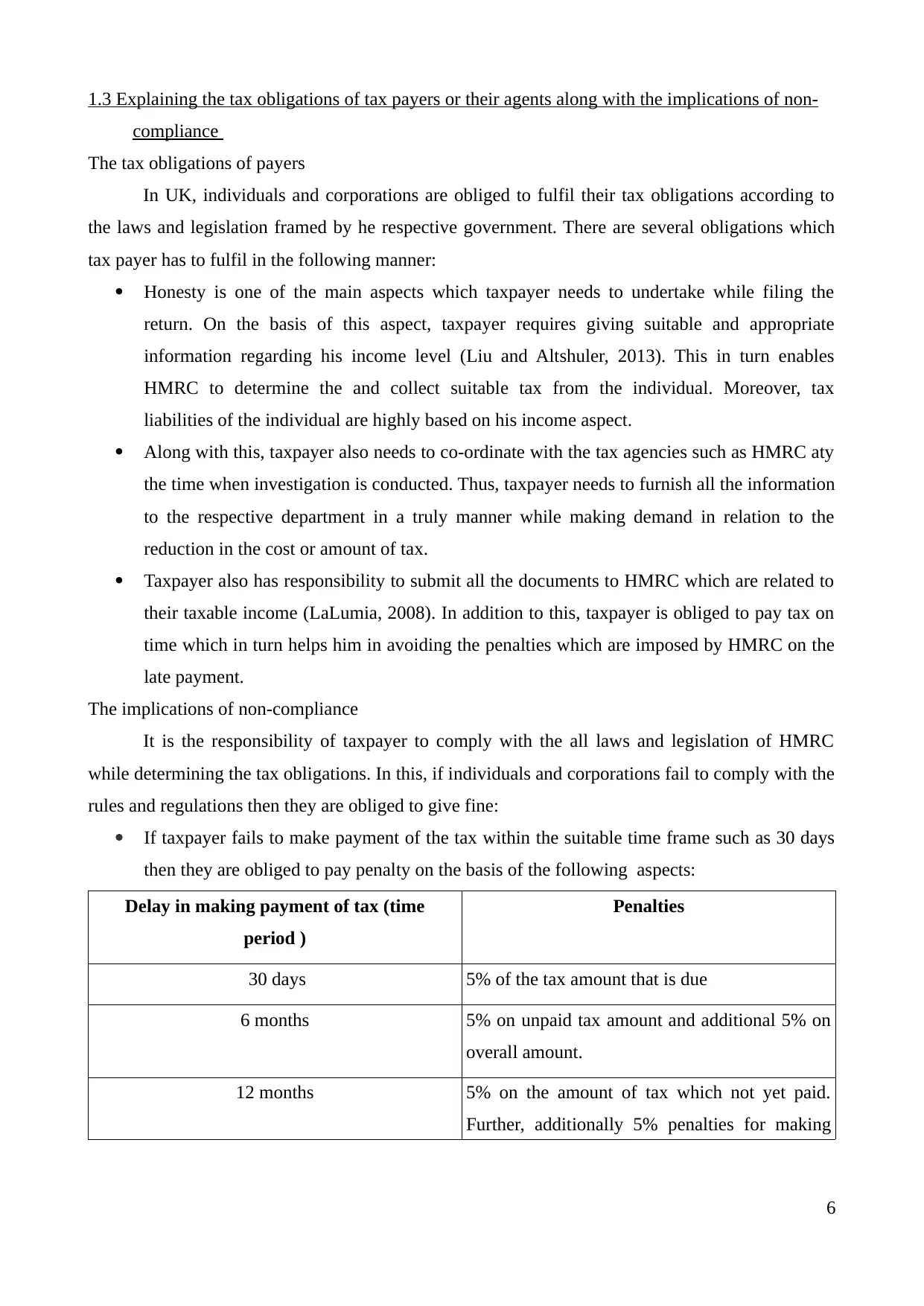
1.3 Explaining the tax obligations of tax payers or their agents along with the implications of non-
compliance
The tax obligations of payers
In UK, individuals and corporations are obliged to fulfil their tax obligations according to
the laws and legislation framed by he respective government. There are several obligations which
tax payer has to fulfil in the following manner:
Honesty is one of the main aspects which taxpayer needs to undertake while filing the
return. On the basis of this aspect, taxpayer requires giving suitable and appropriate
information regarding his income level (Liu and Altshuler, 2013). This in turn enables
HMRC to determine the and collect suitable tax from the individual. Moreover, tax
liabilities of the individual are highly based on his income aspect.
Along with this, taxpayer also needs to co-ordinate with the tax agencies such as HMRC aty
the time when investigation is conducted. Thus, taxpayer needs to furnish all the information
to the respective department in a truly manner while making demand in relation to the
reduction in the cost or amount of tax.
Taxpayer also has responsibility to submit all the documents to HMRC which are related to
their taxable income (LaLumia, 2008). In addition to this, taxpayer is obliged to pay tax on
time which in turn helps him in avoiding the penalties which are imposed by HMRC on the
late payment.
The implications of non-compliance
It is the responsibility of taxpayer to comply with the all laws and legislation of HMRC
while determining the tax obligations. In this, if individuals and corporations fail to comply with the
rules and regulations then they are obliged to give fine:
If taxpayer fails to make payment of the tax within the suitable time frame such as 30 days
then they are obliged to pay penalty on the basis of the following aspects:
Delay in making payment of tax (time
period )
Penalties
30 days 5% of the tax amount that is due
6 months 5% on unpaid tax amount and additional 5% on
overall amount.
12 months 5% on the amount of tax which not yet paid.
Further, additionally 5% penalties for making
6
compliance
The tax obligations of payers
In UK, individuals and corporations are obliged to fulfil their tax obligations according to
the laws and legislation framed by he respective government. There are several obligations which
tax payer has to fulfil in the following manner:
Honesty is one of the main aspects which taxpayer needs to undertake while filing the
return. On the basis of this aspect, taxpayer requires giving suitable and appropriate
information regarding his income level (Liu and Altshuler, 2013). This in turn enables
HMRC to determine the and collect suitable tax from the individual. Moreover, tax
liabilities of the individual are highly based on his income aspect.
Along with this, taxpayer also needs to co-ordinate with the tax agencies such as HMRC aty
the time when investigation is conducted. Thus, taxpayer needs to furnish all the information
to the respective department in a truly manner while making demand in relation to the
reduction in the cost or amount of tax.
Taxpayer also has responsibility to submit all the documents to HMRC which are related to
their taxable income (LaLumia, 2008). In addition to this, taxpayer is obliged to pay tax on
time which in turn helps him in avoiding the penalties which are imposed by HMRC on the
late payment.
The implications of non-compliance
It is the responsibility of taxpayer to comply with the all laws and legislation of HMRC
while determining the tax obligations. In this, if individuals and corporations fail to comply with the
rules and regulations then they are obliged to give fine:
If taxpayer fails to make payment of the tax within the suitable time frame such as 30 days
then they are obliged to pay penalty on the basis of the following aspects:
Delay in making payment of tax (time
period )
Penalties
30 days 5% of the tax amount that is due
6 months 5% on unpaid tax amount and additional 5% on
overall amount.
12 months 5% on the amount of tax which not yet paid.
Further, additionally 5% penalties for making
6
⊘ This is a preview!⊘
Do you want full access?
Subscribe today to unlock all pages.

Trusted by 1+ million students worldwide
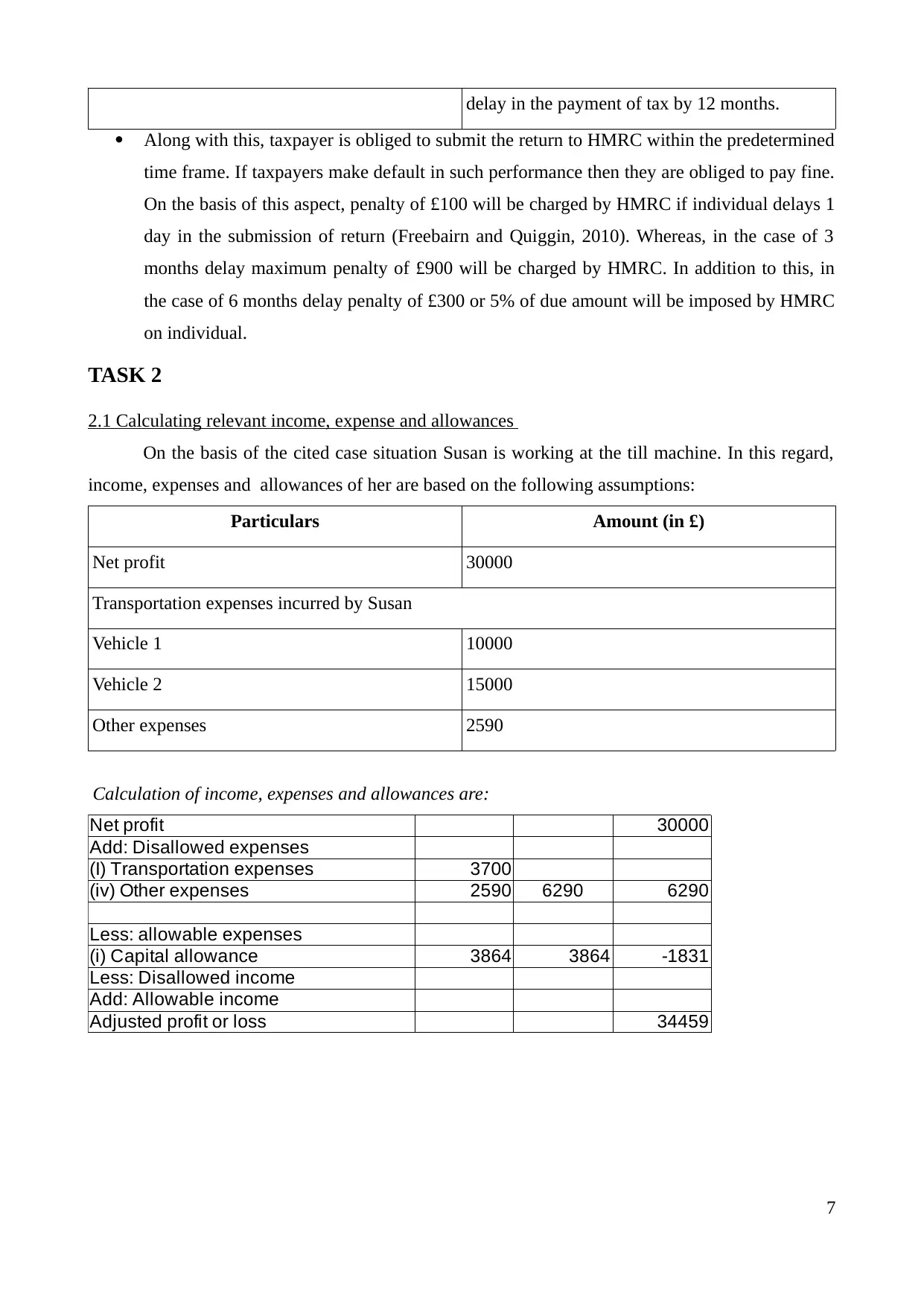
delay in the payment of tax by 12 months.
Along with this, taxpayer is obliged to submit the return to HMRC within the predetermined
time frame. If taxpayers make default in such performance then they are obliged to pay fine.
On the basis of this aspect, penalty of £100 will be charged by HMRC if individual delays 1
day in the submission of return (Freebairn and Quiggin, 2010). Whereas, in the case of 3
months delay maximum penalty of £900 will be charged by HMRC. In addition to this, in
the case of 6 months delay penalty of £300 or 5% of due amount will be imposed by HMRC
on individual.
TASK 2
2.1 Calculating relevant income, expense and allowances
On the basis of the cited case situation Susan is working at the till machine. In this regard,
income, expenses and allowances of her are based on the following assumptions:
Particulars Amount (in £)
Net profit 30000
Transportation expenses incurred by Susan
Vehicle 1 10000
Vehicle 2 15000
Other expenses 2590
Calculation of income, expenses and allowances are:
Net profit 30000
Add: Disallowed expenses
(I) Transportation expenses 3700
(iv) Other expenses 2590 6290 6290
Less: allowable expenses
(i) Capital allowance 3864 3864 -1831
Less: Disallowed income
Add: Allowable income
Adjusted profit or loss 34459
7
Along with this, taxpayer is obliged to submit the return to HMRC within the predetermined
time frame. If taxpayers make default in such performance then they are obliged to pay fine.
On the basis of this aspect, penalty of £100 will be charged by HMRC if individual delays 1
day in the submission of return (Freebairn and Quiggin, 2010). Whereas, in the case of 3
months delay maximum penalty of £900 will be charged by HMRC. In addition to this, in
the case of 6 months delay penalty of £300 or 5% of due amount will be imposed by HMRC
on individual.
TASK 2
2.1 Calculating relevant income, expense and allowances
On the basis of the cited case situation Susan is working at the till machine. In this regard,
income, expenses and allowances of her are based on the following assumptions:
Particulars Amount (in £)
Net profit 30000
Transportation expenses incurred by Susan
Vehicle 1 10000
Vehicle 2 15000
Other expenses 2590
Calculation of income, expenses and allowances are:
Net profit 30000
Add: Disallowed expenses
(I) Transportation expenses 3700
(iv) Other expenses 2590 6290 6290
Less: allowable expenses
(i) Capital allowance 3864 3864 -1831
Less: Disallowed income
Add: Allowable income
Adjusted profit or loss 34459
7
Paraphrase This Document
Need a fresh take? Get an instant paraphrase of this document with our AI Paraphraser
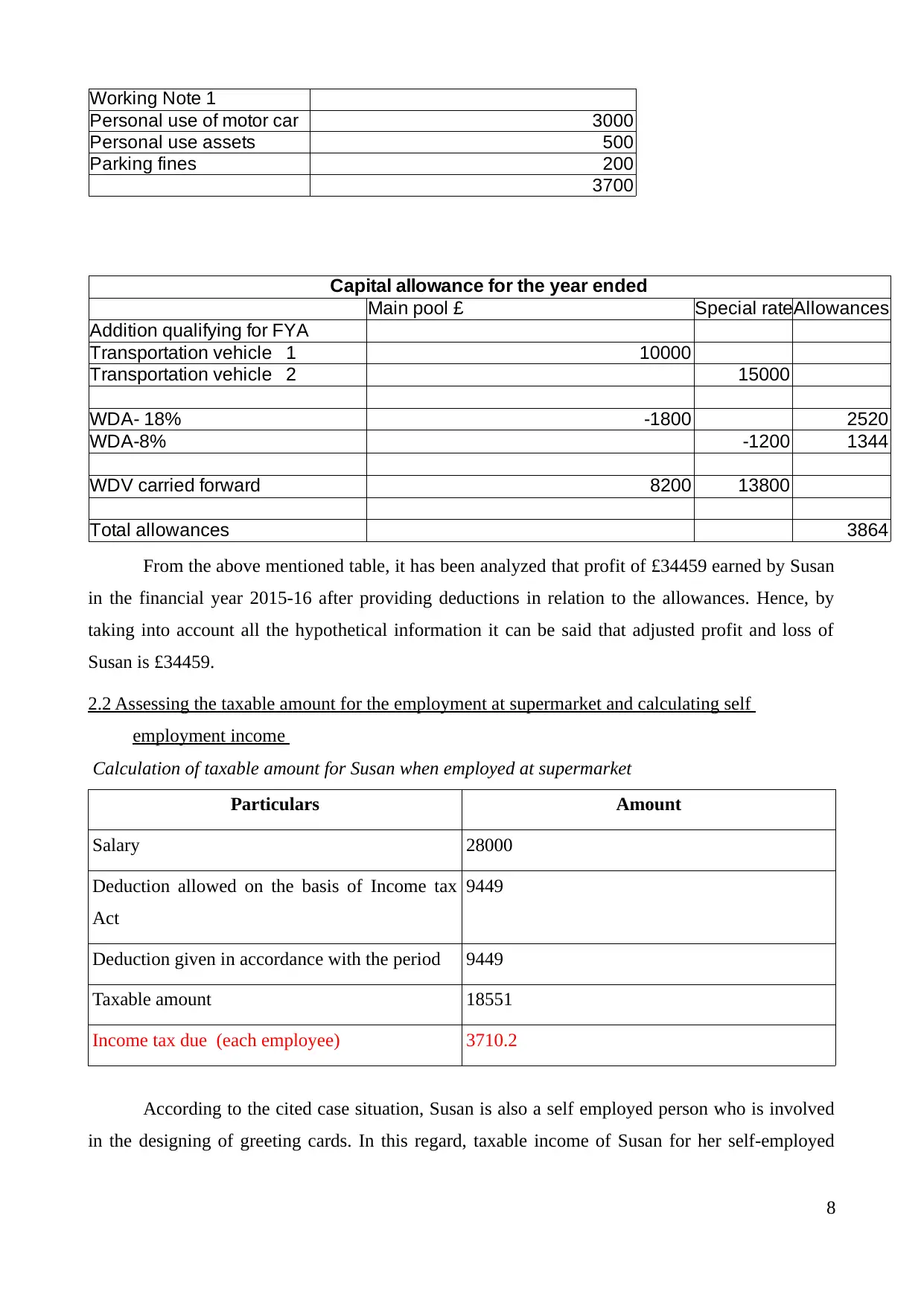
Working Note 1
Personal use of motor car 3000
Personal use assets 500
Parking fines 200
3700
Capital allowance for the year ended
Main pool £ Special rate pool £Allowances £
Addition qualifying for FYA
Transportation vehicle 1 10000
Transportation vehicle 2 15000
WDA- 18% -1800 2520
WDA-8% -1200 1344
WDV carried forward 8200 13800
Total allowances 3864
From the above mentioned table, it has been analyzed that profit of £34459 earned by Susan
in the financial year 2015-16 after providing deductions in relation to the allowances. Hence, by
taking into account all the hypothetical information it can be said that adjusted profit and loss of
Susan is £34459.
2.2 Assessing the taxable amount for the employment at supermarket and calculating self
employment income
Calculation of taxable amount for Susan when employed at supermarket
Particulars Amount
Salary 28000
Deduction allowed on the basis of Income tax
Act
9449
Deduction given in accordance with the period 9449
Taxable amount 18551
Income tax due (each employee) 3710.2
According to the cited case situation, Susan is also a self employed person who is involved
in the designing of greeting cards. In this regard, taxable income of Susan for her self-employed
8
Personal use of motor car 3000
Personal use assets 500
Parking fines 200
3700
Capital allowance for the year ended
Main pool £ Special rate pool £Allowances £
Addition qualifying for FYA
Transportation vehicle 1 10000
Transportation vehicle 2 15000
WDA- 18% -1800 2520
WDA-8% -1200 1344
WDV carried forward 8200 13800
Total allowances 3864
From the above mentioned table, it has been analyzed that profit of £34459 earned by Susan
in the financial year 2015-16 after providing deductions in relation to the allowances. Hence, by
taking into account all the hypothetical information it can be said that adjusted profit and loss of
Susan is £34459.
2.2 Assessing the taxable amount for the employment at supermarket and calculating self
employment income
Calculation of taxable amount for Susan when employed at supermarket
Particulars Amount
Salary 28000
Deduction allowed on the basis of Income tax
Act
9449
Deduction given in accordance with the period 9449
Taxable amount 18551
Income tax due (each employee) 3710.2
According to the cited case situation, Susan is also a self employed person who is involved
in the designing of greeting cards. In this regard, taxable income of Susan for her self-employed
8
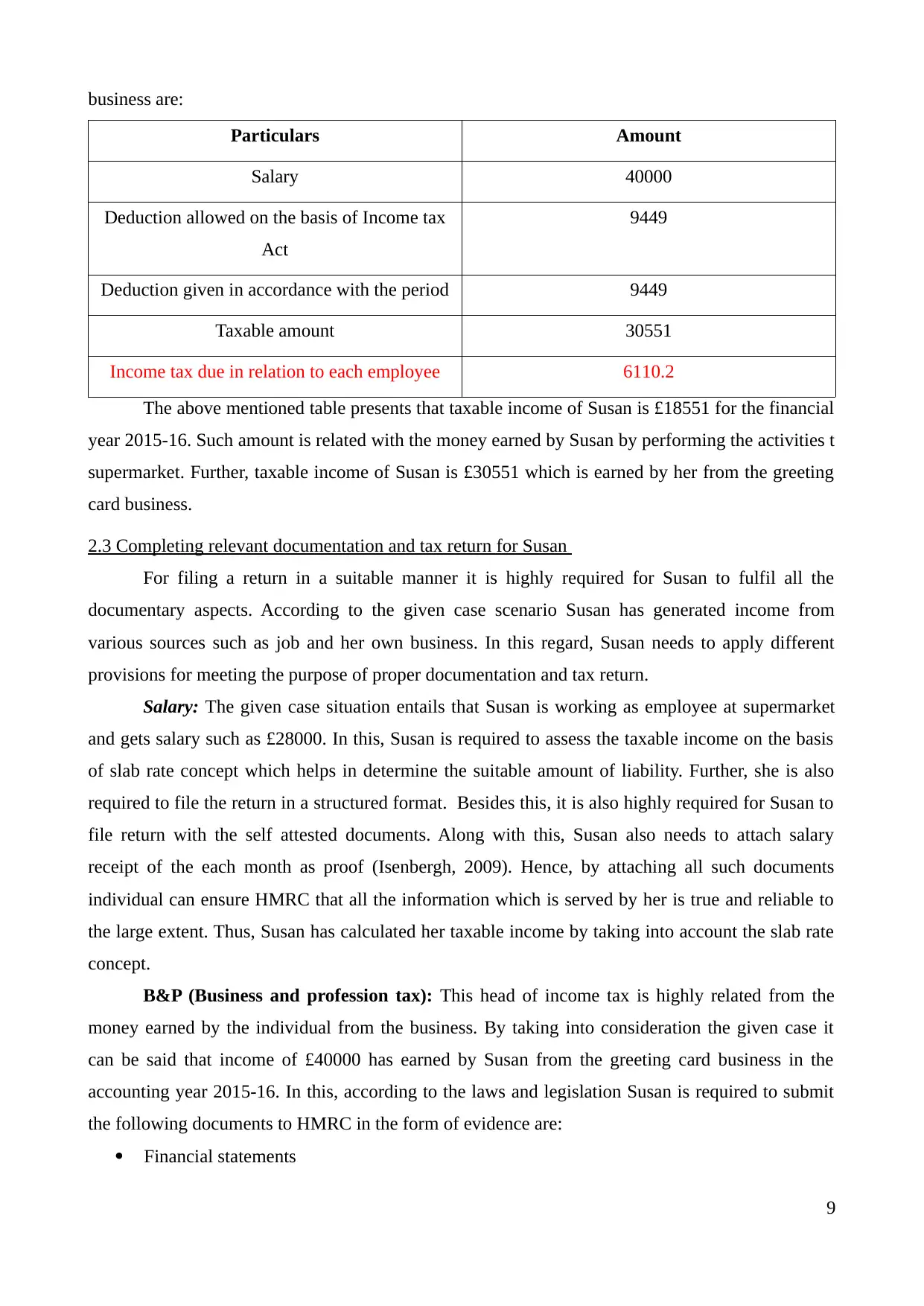
business are:
Particulars Amount
Salary 40000
Deduction allowed on the basis of Income tax
Act
9449
Deduction given in accordance with the period 9449
Taxable amount 30551
Income tax due in relation to each employee 6110.2
The above mentioned table presents that taxable income of Susan is £18551 for the financial
year 2015-16. Such amount is related with the money earned by Susan by performing the activities t
supermarket. Further, taxable income of Susan is £30551 which is earned by her from the greeting
card business.
2.3 Completing relevant documentation and tax return for Susan
For filing a return in a suitable manner it is highly required for Susan to fulfil all the
documentary aspects. According to the given case scenario Susan has generated income from
various sources such as job and her own business. In this regard, Susan needs to apply different
provisions for meeting the purpose of proper documentation and tax return.
Salary: The given case situation entails that Susan is working as employee at supermarket
and gets salary such as £28000. In this, Susan is required to assess the taxable income on the basis
of slab rate concept which helps in determine the suitable amount of liability. Further, she is also
required to file the return in a structured format. Besides this, it is also highly required for Susan to
file return with the self attested documents. Along with this, Susan also needs to attach salary
receipt of the each month as proof (Isenbergh, 2009). Hence, by attaching all such documents
individual can ensure HMRC that all the information which is served by her is true and reliable to
the large extent. Thus, Susan has calculated her taxable income by taking into account the slab rate
concept.
B&P (Business and profession tax): This head of income tax is highly related from the
money earned by the individual from the business. By taking into consideration the given case it
can be said that income of £40000 has earned by Susan from the greeting card business in the
accounting year 2015-16. In this, according to the laws and legislation Susan is required to submit
the following documents to HMRC in the form of evidence are:
Financial statements
9
Particulars Amount
Salary 40000
Deduction allowed on the basis of Income tax
Act
9449
Deduction given in accordance with the period 9449
Taxable amount 30551
Income tax due in relation to each employee 6110.2
The above mentioned table presents that taxable income of Susan is £18551 for the financial
year 2015-16. Such amount is related with the money earned by Susan by performing the activities t
supermarket. Further, taxable income of Susan is £30551 which is earned by her from the greeting
card business.
2.3 Completing relevant documentation and tax return for Susan
For filing a return in a suitable manner it is highly required for Susan to fulfil all the
documentary aspects. According to the given case scenario Susan has generated income from
various sources such as job and her own business. In this regard, Susan needs to apply different
provisions for meeting the purpose of proper documentation and tax return.
Salary: The given case situation entails that Susan is working as employee at supermarket
and gets salary such as £28000. In this, Susan is required to assess the taxable income on the basis
of slab rate concept which helps in determine the suitable amount of liability. Further, she is also
required to file the return in a structured format. Besides this, it is also highly required for Susan to
file return with the self attested documents. Along with this, Susan also needs to attach salary
receipt of the each month as proof (Isenbergh, 2009). Hence, by attaching all such documents
individual can ensure HMRC that all the information which is served by her is true and reliable to
the large extent. Thus, Susan has calculated her taxable income by taking into account the slab rate
concept.
B&P (Business and profession tax): This head of income tax is highly related from the
money earned by the individual from the business. By taking into consideration the given case it
can be said that income of £40000 has earned by Susan from the greeting card business in the
accounting year 2015-16. In this, according to the laws and legislation Susan is required to submit
the following documents to HMRC in the form of evidence are:
Financial statements
9
⊘ This is a preview!⊘
Do you want full access?
Subscribe today to unlock all pages.

Trusted by 1+ million students worldwide
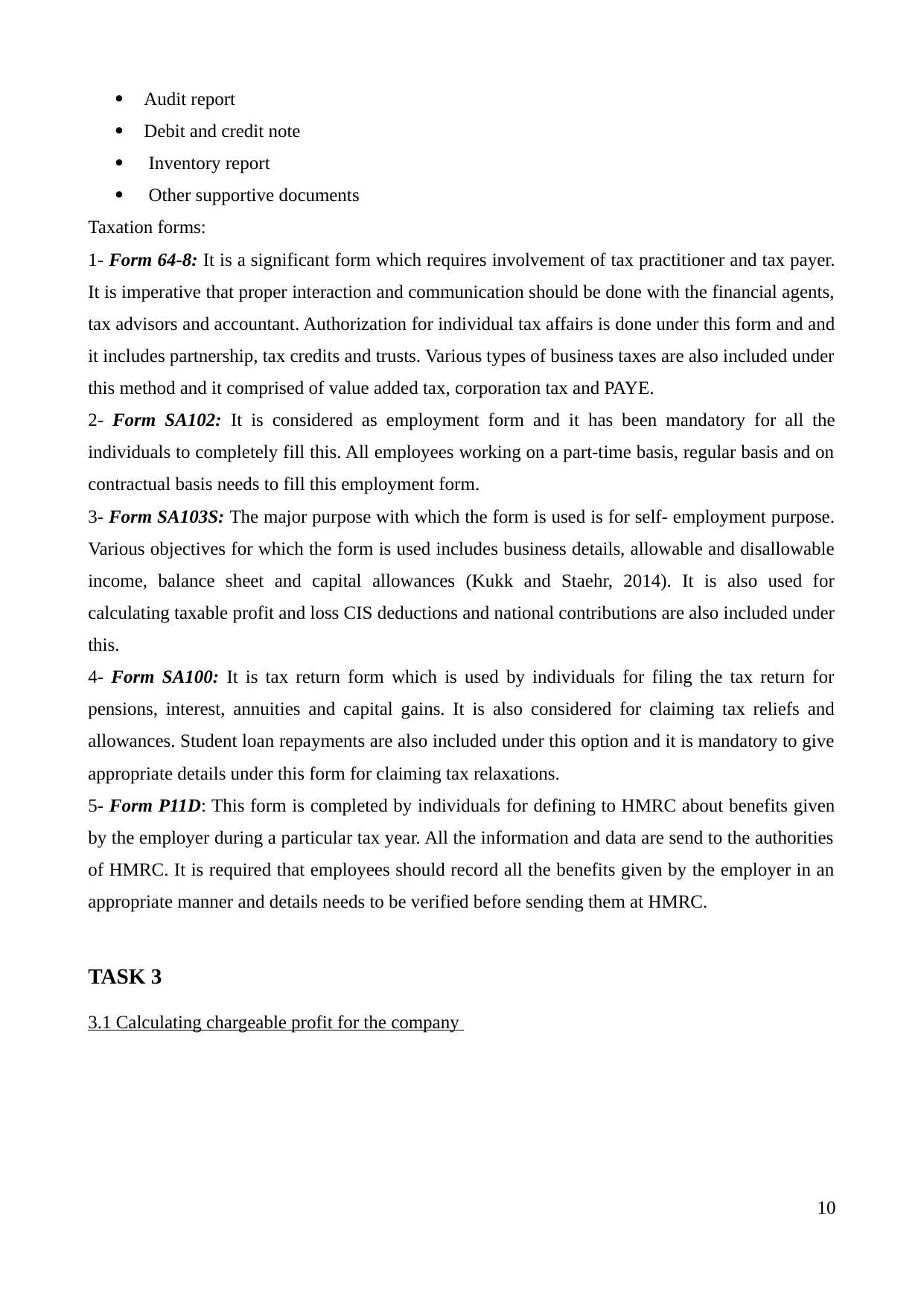
Audit report
Debit and credit note
Inventory report
Other supportive documents
Taxation forms:
1- Form 64-8: It is a significant form which requires involvement of tax practitioner and tax payer.
It is imperative that proper interaction and communication should be done with the financial agents,
tax advisors and accountant. Authorization for individual tax affairs is done under this form and and
it includes partnership, tax credits and trusts. Various types of business taxes are also included under
this method and it comprised of value added tax, corporation tax and PAYE.
2- Form SA102: It is considered as employment form and it has been mandatory for all the
individuals to completely fill this. All employees working on a part-time basis, regular basis and on
contractual basis needs to fill this employment form.
3- Form SA103S: The major purpose with which the form is used is for self- employment purpose.
Various objectives for which the form is used includes business details, allowable and disallowable
income, balance sheet and capital allowances (Kukk and Staehr, 2014). It is also used for
calculating taxable profit and loss CIS deductions and national contributions are also included under
this.
4- Form SA100: It is tax return form which is used by individuals for filing the tax return for
pensions, interest, annuities and capital gains. It is also considered for claiming tax reliefs and
allowances. Student loan repayments are also included under this option and it is mandatory to give
appropriate details under this form for claiming tax relaxations.
5- Form P11D: This form is completed by individuals for defining to HMRC about benefits given
by the employer during a particular tax year. All the information and data are send to the authorities
of HMRC. It is required that employees should record all the benefits given by the employer in an
appropriate manner and details needs to be verified before sending them at HMRC.
TASK 3
3.1 Calculating chargeable profit for the company
10
Debit and credit note
Inventory report
Other supportive documents
Taxation forms:
1- Form 64-8: It is a significant form which requires involvement of tax practitioner and tax payer.
It is imperative that proper interaction and communication should be done with the financial agents,
tax advisors and accountant. Authorization for individual tax affairs is done under this form and and
it includes partnership, tax credits and trusts. Various types of business taxes are also included under
this method and it comprised of value added tax, corporation tax and PAYE.
2- Form SA102: It is considered as employment form and it has been mandatory for all the
individuals to completely fill this. All employees working on a part-time basis, regular basis and on
contractual basis needs to fill this employment form.
3- Form SA103S: The major purpose with which the form is used is for self- employment purpose.
Various objectives for which the form is used includes business details, allowable and disallowable
income, balance sheet and capital allowances (Kukk and Staehr, 2014). It is also used for
calculating taxable profit and loss CIS deductions and national contributions are also included under
this.
4- Form SA100: It is tax return form which is used by individuals for filing the tax return for
pensions, interest, annuities and capital gains. It is also considered for claiming tax reliefs and
allowances. Student loan repayments are also included under this option and it is mandatory to give
appropriate details under this form for claiming tax relaxations.
5- Form P11D: This form is completed by individuals for defining to HMRC about benefits given
by the employer during a particular tax year. All the information and data are send to the authorities
of HMRC. It is required that employees should record all the benefits given by the employer in an
appropriate manner and details needs to be verified before sending them at HMRC.
TASK 3
3.1 Calculating chargeable profit for the company
10
Paraphrase This Document
Need a fresh take? Get an instant paraphrase of this document with our AI Paraphraser
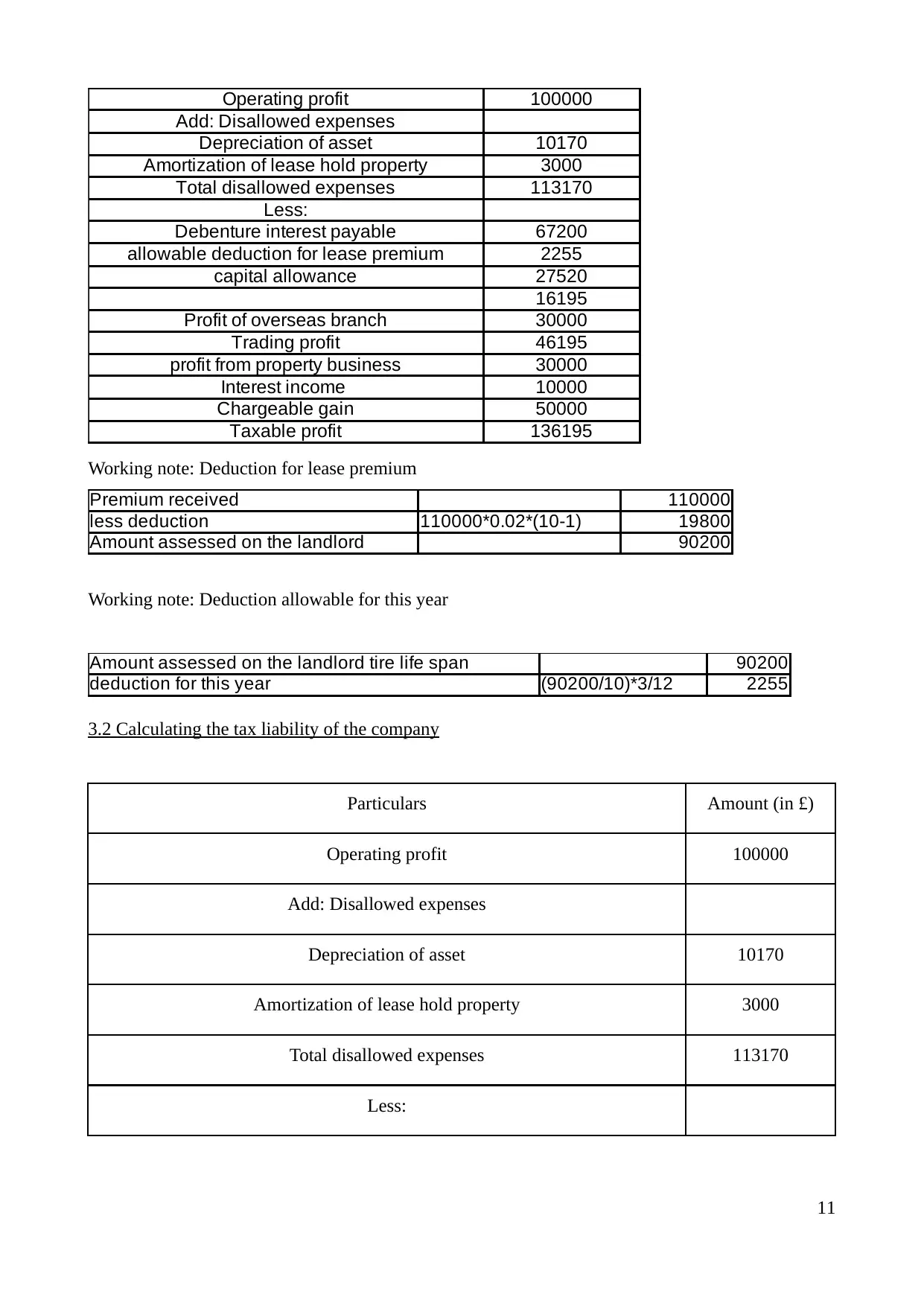
Operating profit 100000
Add: Disallowed expenses
Depreciation of asset 10170
Amortization of lease hold property 3000
Total disallowed expenses 113170
Less:
Debenture interest payable 67200
allowable deduction for lease premium 2255
capital allowance 27520
16195
Profit of overseas branch 30000
Trading profit 46195
profit from property business 30000
Interest income 10000
Chargeable gain 50000
Taxable profit 136195
Working note: Deduction for lease premium
Premium received 110000
less deduction 110000*0.02*(10-1) 19800
Amount assessed on the landlord 90200
Working note: Deduction allowable for this year
Amount assessed on the landlord tire life span 90200
deduction for this year (90200/10)*3/12 2255
3.2 Calculating the tax liability of the company
Particulars Amount (in £)
Operating profit 100000
Add: Disallowed expenses
Depreciation of asset 10170
Amortization of lease hold property 3000
Total disallowed expenses 113170
Less:
11
Add: Disallowed expenses
Depreciation of asset 10170
Amortization of lease hold property 3000
Total disallowed expenses 113170
Less:
Debenture interest payable 67200
allowable deduction for lease premium 2255
capital allowance 27520
16195
Profit of overseas branch 30000
Trading profit 46195
profit from property business 30000
Interest income 10000
Chargeable gain 50000
Taxable profit 136195
Working note: Deduction for lease premium
Premium received 110000
less deduction 110000*0.02*(10-1) 19800
Amount assessed on the landlord 90200
Working note: Deduction allowable for this year
Amount assessed on the landlord tire life span 90200
deduction for this year (90200/10)*3/12 2255
3.2 Calculating the tax liability of the company
Particulars Amount (in £)
Operating profit 100000
Add: Disallowed expenses
Depreciation of asset 10170
Amortization of lease hold property 3000
Total disallowed expenses 113170
Less:
11
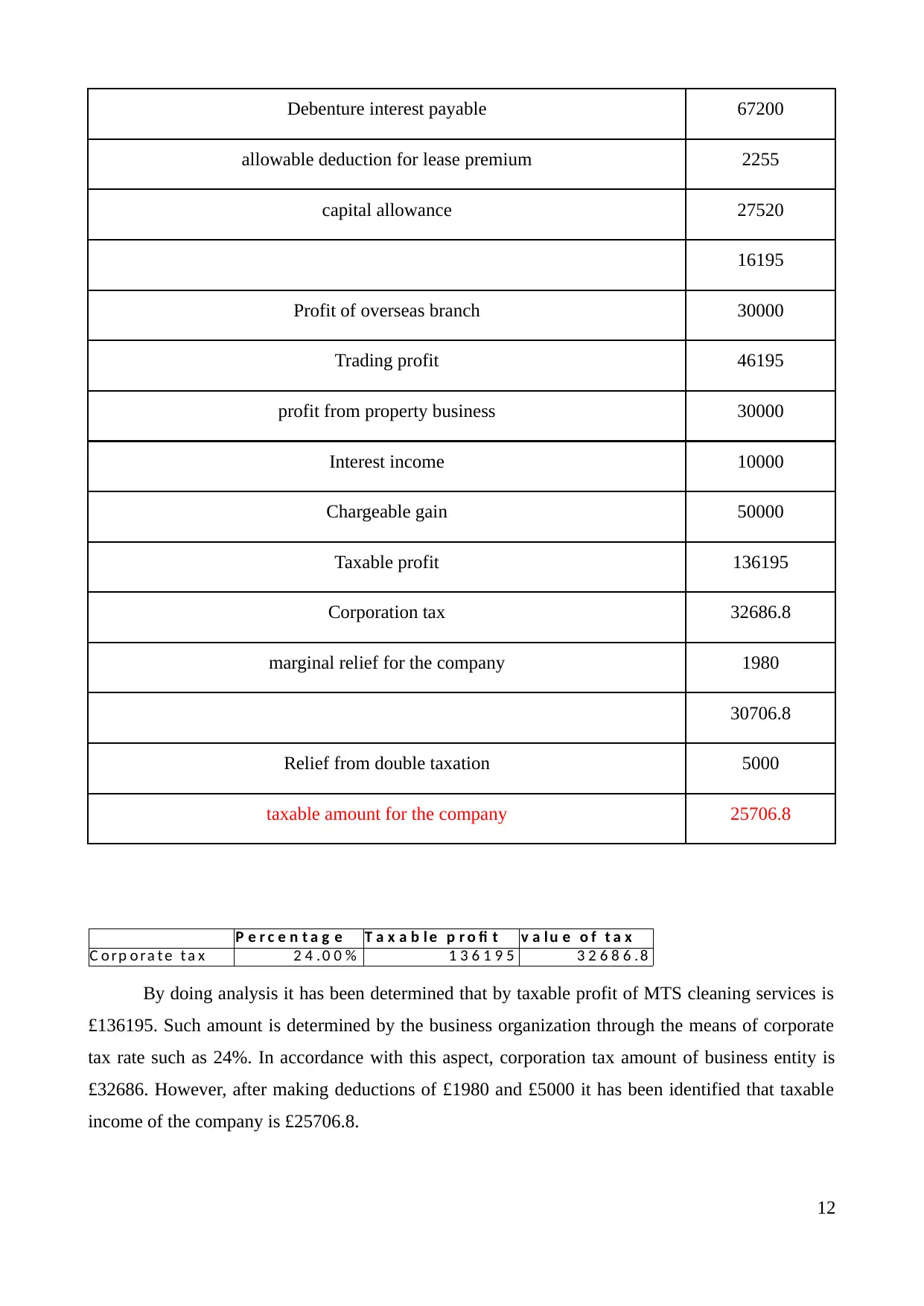
Debenture interest payable 67200
allowable deduction for lease premium 2255
capital allowance 27520
16195
Profit of overseas branch 30000
Trading profit 46195
profit from property business 30000
Interest income 10000
Chargeable gain 50000
Taxable profit 136195
Corporation tax 32686.8
marginal relief for the company 1980
30706.8
Relief from double taxation 5000
taxable amount for the company 25706.8
P e r c e n t a g e T a x a b l e p r o fi t v a l u e o f t a x
C o rp o ra t e t a x 2 4 . 0 0 % 1 3 6 1 9 5 3 2 6 8 6 . 8
By doing analysis it has been determined that by taxable profit of MTS cleaning services is
£136195. Such amount is determined by the business organization through the means of corporate
tax rate such as 24%. In accordance with this aspect, corporation tax amount of business entity is
£32686. However, after making deductions of £1980 and £5000 it has been identified that taxable
income of the company is £25706.8.
12
allowable deduction for lease premium 2255
capital allowance 27520
16195
Profit of overseas branch 30000
Trading profit 46195
profit from property business 30000
Interest income 10000
Chargeable gain 50000
Taxable profit 136195
Corporation tax 32686.8
marginal relief for the company 1980
30706.8
Relief from double taxation 5000
taxable amount for the company 25706.8
P e r c e n t a g e T a x a b l e p r o fi t v a l u e o f t a x
C o rp o ra t e t a x 2 4 . 0 0 % 1 3 6 1 9 5 3 2 6 8 6 . 8
By doing analysis it has been determined that by taxable profit of MTS cleaning services is
£136195. Such amount is determined by the business organization through the means of corporate
tax rate such as 24%. In accordance with this aspect, corporation tax amount of business entity is
£32686. However, after making deductions of £1980 and £5000 it has been identified that taxable
income of the company is £25706.8.
12
⊘ This is a preview!⊘
Do you want full access?
Subscribe today to unlock all pages.

Trusted by 1+ million students worldwide
1 out of 16
Related Documents
Your All-in-One AI-Powered Toolkit for Academic Success.
+13062052269
info@desklib.com
Available 24*7 on WhatsApp / Email
![[object Object]](/_next/static/media/star-bottom.7253800d.svg)
Unlock your academic potential
Copyright © 2020–2025 A2Z Services. All Rights Reserved. Developed and managed by ZUCOL.





